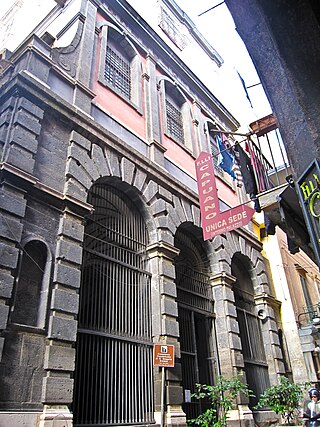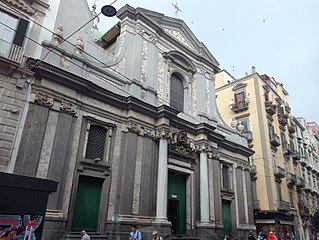
Santa Cristina is a Baroque-style, Roman Catholic church located on via Repubblica in Parma, region of Emilia-Romagna, Italy.

Santa Cristina is a Baroque-style, Roman Catholic church located on via Repubblica in Parma, region of Emilia-Romagna, Italy.
The present church of Santa Cristina and its adjacent monastery were erected at the site of some ruined building and a 10th-century parish church of San Siro. [1] This marked the eastern limit of Parma, and was the name attached to the gate of the town leading to Reggio. With the patronage of the Duchess Margherita Aldobrandini, widow of Ranuccio I Farnese, in a bull dated 22 January 1629, the Pope Urban VIII Barberini entrusted the complex to the Theatine order. [2] In 1649 the Theatines utilized a design which one of its members, Pietro Caracciolo, had developed for the church of San Vicenzo in Piacenza. Work continued until 1662 in the church, and the monastery till 1732. The Theatines remained here until 1805.

The building has three naves divided by pillars with Ionic capitals, with four chapels on each side in front of each of which opens a hemispherical dome. The facade and the apse remained unfinished. The interior was frescoed by the figure painter and Theatine Filippo Maria Galletti and quadratura by and other painting by Alessandro Baratta. Most of the altarpieces depicting the Life of the Virgin were painted by Giovanni Battista Venanzi, including the main altarpiece depicting the Martyrdom and Glory of Ste Cristina. The ceiling of the nave is decorated with four scenes from the life of St Cajetan: the Virgin appears to a dying St Cajetan, framed by allegories of Humility and Faith; Glory of St Cajetan before the Trinity, between allegories of Obedience and Temperance; Vision of the Virgin and Child to Cajetan during his first Mass, between Providence and Justice; and finally, Cajetan contemplates the signs of the Passion, between Hope and Charity.
In the side walls, on the sides of the windows that illuminate the central nave, are the figures of the apostles and evangelists and below, on the sides of the arches, those of the prophets .
Among the other paintings, are a Saint Nicolas by a follower of Lionello Spada, a Deposition by Donnino Pozzi; and the Glory of St Joseph with the blessed Theatine Paolo Burali , painted in 1722 by Francesco Nassi. The choir was added to the central door in 1720, with the organ built in 1764 by Antonio Poncini Negri, damaged in the bombings of 1944 and restored in 1983 by the Tamburini company from Asciano. [3]

Lorenzo Lotto was an Italian painter, draughtsman, and illustrator, traditionally placed in the Venetian school, though much of his career was spent in other north Italian cities. He painted mainly altarpieces, religious subjects and portraits. He was active during the High Renaissance and the first half of the Mannerist period, but his work maintained a generally similar High Renaissance style throughout his career, although his nervous and eccentric posings and distortions represented a transitional stage to the Florentine and Roman Mannerists.

The Chiesa di San Giacomo dall'Orio is a church located in the sestiere (quarter) of Santa Croce in Venice, northern Italy.

Sant'Andrea della Valle is a minor basilica in the rione of Sant'Eustachio of the city of Rome, Italy. The basilica is the general seat for the religious order of the Theatines. It is located at Piazza Vidoni, at the intersection of Corso Vittorio Emanuele and Corso Rinascimento.

San Gregorio Armeno is a church and a monastery in Naples, Italy. It is one of the most important Baroque complexes in Naples. The church is located on a street of the same name just south of Via dei Tribunali and a few blocks south of the church of San Paolo Maggiore, Naples

Santa Maria in Vallicella, also called Chiesa Nuova, is a church in Rome, Italy, which today faces onto the main thoroughfare of the Corso Vittorio Emanuele and the corner of Via della Chiesa Nuova. It is the principal church of the Oratorians, a religious congregation of secular priests, founded by St Philip Neri in 1561 at a time in the 16th century when the Counter Reformation saw the emergence of a number of new religious organisations such as the Society of Jesus (Jesuits), the Theatines and the Barnabites.

Sant'Anna dei Lombardi,, and also known as Santa Maria di Monte Oliveto, is an ancient church and convent located in piazza Monteoliveto in central Naples, Italy. Across Monteoliveto street from the Fountain in the square is the Renaissance palace of Orsini di Gravina.
Alfonso Rivarola was an Italian painter of the Baroque period, active mainly in Ferrara, where he was born. He is also known as il Chenda because of an inheritance he received from someone with that name.

San Francesco della Vigna is a Roman Catholic church in the Sestiere of Castello in Venice, northern Italy.

San Paolo Maggiore is a basilica church in Naples, southern Italy, and the burial place of Saint Cajetan, founder of the Theatines. It is located on Piazza Gaetano, about 1-2 blocks north of Via dei Tribunali.

San Gaetano, also known as Santi Michele e Gaetano, is a Baroque church in Florence, Italy, located on the Piazza Antinori, entrusted to the Institute of Christ the King Sovereign Priest.

San Giovanni Evangelista is a church in Parma, northern Italy, part of a complex also including a Benedictine convent and the San Giovanni Old pharmacy.

The Church of San Gaetano is found in the central district of Padua, and its facade was designed by the late Renaissance architect Vincenzo Scamozzi.

The church of St. Nicholas the Charitable is a church located on via Toledo, almost midway between Piazza Carità and Piazza Dante in Naples, Italy.

The church of Santa Maria delle Grazie in Brescia is located on at the west end of Via Elia Capriolo, where it intersects with the Via delle Grazie. Built in the 16th century and remodeled in the 17th century, it still retains much of its artwork by major regional artists, including one of its three canvases by Moretto. The other two are now held at the Pinacoteca Tosio Martinengo. The interior is richly decorated in Baroque fashion. Adjacent to the church is the Sanctuary of Santa Maria delle Grazie, a neo-gothic work.

San Vitale is a Baroque style, Roman Catholic church located in central Parma, region of Emilia Romagna, Italy.

The Church of the Theatines (Teatini), also known as Santa Maria della Pietà is a Roman Catholic, Baroque-style church and monastery located on Corso della Giovecca, in central Ferrara, region of Emilia-Romagna, Italy.

The Church of Santa Sofia is a Roman Catholic church in the city of Lendinara, in the Province of Rovigo, region of Veneto, Italy.

Santa Caterina d'Alessandria or Saint Catherine of Alexandria is a Roman Catholic church with a main facade on Piazza Bellini, and a lateral Western facade facing the elaborate Fontana Pretoria, in the historic quarter of Kalsa in the city of Palermo, region of Sicily, Italy. In front of the main facade, across the piazza Bellini, rise the older churches of San Cataldo and Santa Maria dell'Ammiraglio, while across Piazza Pretoria is the Theatine church of San Giuseppe and the entrance to the Quattro Canti. Refurbished over the centuries, the church retains elements and decorations from the Renaissance, Baroque, and late-Baroque (Rococo) eras. This church is distinct from the Oratorio di Santa Caterina found in the Olivella neighborhood.

San Filippo Neri is a baroque-style, Roman Catholic church located on the intersection of Corso della Republica and via Santa Maria della Porta, in central Macerata, region of Marche, Italy.
San Vincenzo is a Baroque style, Roman Catholic church, now deconsecrated, located at Via Scalabrini #6 in the South-East quadrant of Piacenza, Region of Emilia Romagna, Italy. The church was restored starting in 2009 for use as an auditorium and to host concerts.